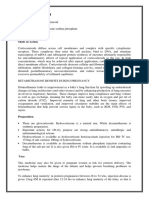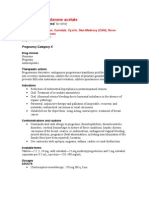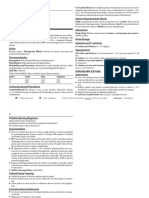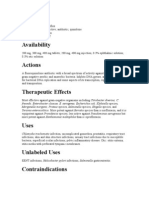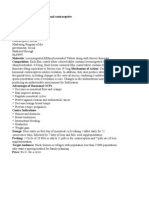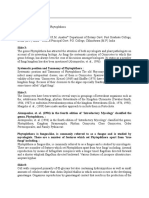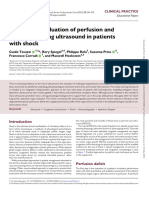Ritodrine
Ritodrine
Uploaded by
Mariquita BuenafeCopyright:
Available Formats
Ritodrine
Ritodrine
Uploaded by
Mariquita BuenafeOriginal Description:
Copyright
Available Formats
Share this document
Did you find this document useful?
Is this content inappropriate?
Copyright:
Available Formats
Ritodrine
Ritodrine
Uploaded by
Mariquita BuenafeCopyright:
Available Formats
Ritodrine Brand name(s): Yutopar; Yutopar S.R.
Category: Tocolytic Indications Accepted Premature labor (prophylaxis and treatment)Intravenous ritodrine is indicated in the treatment of preterm labor in patients with a pregnancy of 20 or more weeks' gestation. Preterm labor is defined as rhythmic uterine contractions less than 10 minutes apart accompanied by progressive cervical effacement and/or dilation before the end of the 37th week of gestation. By prolonging gestation, ritodrine may reduce the incidence of neonatal mortality and respiratory distress syndrome by allowing time for the fetus to age and the fetal lung to mature or time for corticosteroids to be administered to the mother to enhance lung maturity in the fetus. Suitable patients must have intact amniotic membranes, cervical dilation usually but not always less than 4 centimeters (cm), and cervical effacement less than 80%. Use is not recommended prior to the 20th week of pregnancy. For intravenous ritodrine to be most effective, it is recommended that therapy begin as soon as the diagnosis of preterm labor is confirmed. Due to the potential risks for the patient and fetus, a physician experienced in the use of intravenous ritodrine should be present to intervene in case of an emergency. Intravenous ritodrine is less likely to inhibit labor when labor is advanced (cervical dilation more than 4 cm or effacement more than 80%) or when patient is close to term; its use, according to one study, may be best in pregnancies of less than 28 weeks. { Risk-benefit should be cautiously assessed for those women in advanced labor or whose amniotic membranes have ruptured as safety and efficacy have not been established for these patients; use of ritodrine is not recommended. Risk of intrauterine infection when amniotic membranes are ruptured must be considered. Although oral ritodrine is indicated in the treatment of preterm labor in Canada, it is the opinion of the USP Obstetrics and Gynecology Advisory Panel that oral ritodrine cannot be recommended because its efficacy has not been established to be more effective than a placebo and alternative therapies may be more beneficial. Bed rest at home and early admission may be better alternatives than using oral ritodrine in treatment of preterm labor, including retreatment of recurrent preterm labor.
Mechanism of action/Effect: Ritodrine, a beta-2adrenergic agonist, relaxes the uterus by stimulating the beta-2adrenergic receptors of the uterine muscle, which causes a decrease in the intensity and frequency of uterine contractions. Specifically, ritodrine decreases uterine myometrial contractility by increasing cellular cyclic adenosine monophosphate (cAMP) and increasing cell membrane cytokines that increase and
sequester intracellular calcium. Without intracellular calcium, the activation of contractile protein of smooth muscle is prevented and the uterus relaxes Other actions/effects: In addition to stimulating the beta-2adrenergic receptors of the uterine smooth muscle, ritodrine stimulates beta-adrenergic receptors of bronchial and vascular smooth muscles. The cardiostimulatory effects, including increased cardiac output, increased maternal and fetal heart rates, and widening of the maternal pulse pressure, are probably due to relaxation of vascular smooth muscle. Relaxation of vascular smooth muscle stimulates the beta-1adrenergic receptors and the reflex response to blood pressure. Also, during intravenous administration, ritodrine transiently increases maternal and fetal blood glucose and maternal plasma insulin concentrations. Other metabolic changes include increased cAMP, lactic acid, and free fatty acids, and decreased serum potassium concentration. Patient monitoring The following may be especially important in patient monitoring (other tests may be warranted in some patients, depending on condition; = major clinical significance): Assessment of gestational age and fetal maturity (to diagnose preterm labor) Blood count determinations (patients using ritodrine long-term, especially intravenous use for 2 or 3 weeks, should be monitored for development of leukopenia or agranulocytosis ) Blood glucose, maternal and neonatal and Fluid and electrolyte status, maternal and neonatal (should be monitored carefully during prolonged intravenous administration, especially in diabetic patients or those receiving corticosteroids, potassium-depleting diuretics, or digitalis glycosides; neonatal blood glucose should be determined promptly after delivery) Cardiac function monitoring, maternal, such as electrocardiogram (ECG) and/or Pulmonary function monitoring, maternal (baseline ECG should be done to rule out occult maternal cardiac disease; pulmonary function monitoring and an ECG should also be done immediately in patients complaining of chest pain or tightness during ritodrine therapy and ritodrine should be temporarily discontinued until ECG is assessed; a persistent high tachycardia [over 140 beats per minute] may be related to impending pulmonary edema) Heart rate, fetal and Uterine activity (should be monitored frequently during intravenous administration ) Side/Adverse Effects Note: Most adverse effects of ritodrine are related to its beta-adrenergic stimulating activity and are usually dose-related. {03} Maternal ketoacidosis has been reported, especially in patients also receiving high doses of corticosteroids or in patients with poorly controlled diabetes mellitus {03}.
The following side/adverse effects have been selected on the basis of their potential clinical significance (possible signs and symptoms in parentheses where appropriate)not necessarily inclusive: Those indicating need for medical attention Incidence more frequent Angina or cardiac disease, previously undiagnosed (chest pain or tightness)15% with intravenous use diastolic blood pressure reduction, maternal (lightheadedness or dizziness)80 to 100% with intravenous use hyperglycemia, maternal (blurred vision; drowsiness; dry mouth; flushed, dry skin; fruit-like breath odor; increased frequency and volume of urination; ketones in urine; loss of appetite; somnolence; stomachache, nausea, or vomiting; tiredness; troubled breathing, rapid and deep; unconsciousness; unusual thirst)80 to 100% with intravenous use, transient for 48 to 72 hours pulmonary edema (shortness of breath)15% with intravenous use tachycardia or other cardiac arrhythmias, maternal and fetal (fast or irregular heartbeat)1% with oral use and 80 to 100% with intravenous use Incidence rare Agranulocytosis or leukopenia (sore throat or fever)with intravenous use for 2 to 3 weeks, reversible on discontinuation{04} hepatic function impairment or hepatitis (yellow eyes or skin)reported in less than 1% of patients using ritodrine and other beta-adrenergic agonists{03}
Those indicating need for medical attention only if they continue or are bothersome Incidence more frequent Erythema (reddened skin)10 to 50% with intravenous use headache 10 to 50% with intravenous use nausea 5 to 8% with oral use and 10 to 50% with intravenous use palpitations (pounding or racing heartbeat)10 to 15% with oral use and 33% with intravenous use trembling 10 to 15% with oral use and 10 to 50% with intravenous use
vomiting 5 to 8% with oral use and 10 to 50% with intravenous use{ Incidence less frequent or rare Psychological symptoms (anxiety, emotional upset, jitteriness, nervousness, restlessness)5 to 8% with oral or intravenous use skin rash 3 to 4% with oral use and rare with intravenous use Those indicating possible maternal pulmonary edema and need for medical attention if they occur after medication is discontinued Shortness of breath Patient Consultation As an aid to patient consultation, refer to Advice for the Patient, Ritodrine (Systemic). In providing consultation, consider emphasizing the following selected information ( = major clinical significance): Before using this medication Conditions affecting use, especially: Sensitivity to ritodrine or sulfite preservative Other medications, especially beta-adrenergic agonists (other), beta-adrenergic blocking agents, or long-acting corticosteroids Other medical problems, especially abruptio placentae, cardiovascular disease (maternal), chorioamnionitis, diabetes mellitus, eclampsia, hemorrhage (maternal), hypertension (uncontrolled), hyperthyroidism (uncontrolled), hypovolemia, intrauterine fetal death, nonreassuring fetal status, pheochromocytoma, placenta previa, preeclampsia, or pulmonary hypertension
You might also like
- Cell Workout - The No Equipment Workout For Your Small Space (2016) PDFDocument293 pagesCell Workout - The No Equipment Workout For Your Small Space (2016) PDFnenrode5487% (23)
- Sacred G Ebook Opt Version 1-1Document112 pagesSacred G Ebook Opt Version 1-1sunbliss83% (6)
- Defibrillation - E-Learning Quiz 1. Identify The RhythmDocument3 pagesDefibrillation - E-Learning Quiz 1. Identify The RhythmBalaji Chinnasami100% (1)
- Activity Intolerance NCPDocument7 pagesActivity Intolerance NCPMariquita BuenafeNo ratings yet
- Deep WorkDocument9 pagesDeep Workkohinoor_roy5447No ratings yet
- Hand IncisionsDocument55 pagesHand IncisionsDabessa Mosissa100% (2)
- Generic NameDocument6 pagesGeneric NameKimsha ConcepcionNo ratings yet
- Drug Study ON Cabergolin EDocument4 pagesDrug Study ON Cabergolin ESimran SimzNo ratings yet
- AntaraDocument13 pagesAntaraDeepti KukretiNo ratings yet
- INDOMETACINDocument5 pagesINDOMETACINteslimolakunlerajiNo ratings yet
- Betnesol InjectionDocument7 pagesBetnesol Injectionhiral mistryNo ratings yet
- Labetalol Hydro ChlorideDocument3 pagesLabetalol Hydro Chlorideapi-3797941100% (1)
- Levonorgestrel: Mechanism of ActionDocument6 pagesLevonorgestrel: Mechanism of ActionAdditi SatyalNo ratings yet
- Carboprost TromethamineDocument2 pagesCarboprost TromethamineDeathDefying DonutNo ratings yet
- LABETALOL Drug StudyDocument2 pagesLABETALOL Drug StudyLeoNo ratings yet
- Drug Study - CefotaximeDocument5 pagesDrug Study - CefotaximeAngel laurestaNo ratings yet
- Medroxyprogesterone AcetateDocument3 pagesMedroxyprogesterone Acetateapi-3797941No ratings yet
- Obat ObgynDocument8 pagesObat ObgynMuhammad Naqiuddin JalaluddinNo ratings yet
- PiroxicamDocument2 pagesPiroxicamVirginia Aira Lara MarquezNo ratings yet
- Drotaverine: Solution For Injection - 40 MG / 2 MLDocument1 pageDrotaverine: Solution For Injection - 40 MG / 2 MLZarbakht AliNo ratings yet
- Drug Study CaseDocument7 pagesDrug Study CaseKevin Sam AguirreNo ratings yet
- INDOMETHACINDocument1 pageINDOMETHACINRPh Krishna Chandra JagritNo ratings yet
- OxytocinDocument1 pageOxytocinAudrey Martin RañisesNo ratings yet
- MethergineDocument2 pagesMethergineRoseben SomidoNo ratings yet
- Drug Study (Misoprostol)Document3 pagesDrug Study (Misoprostol)Danica Nuevaexcija100% (1)
- Generic Name:: Norgestimate and Ethinyl EstradiolDocument5 pagesGeneric Name:: Norgestimate and Ethinyl EstradiolJay VillasotoNo ratings yet
- CeftriaxoneDocument5 pagesCeftriaxoneCastillo MikaellaNo ratings yet
- Trandate (Labetalol)Document3 pagesTrandate (Labetalol)ENo ratings yet
- DS - Oral Rehydration Salts (ORS)Document2 pagesDS - Oral Rehydration Salts (ORS)Celline Isabelle ReyesNo ratings yet
- DextroseDocument2 pagesDextroseSanket TelangNo ratings yet
- Vit EDocument2 pagesVit EkingpinNo ratings yet
- Drug Study-MethyldopaDocument4 pagesDrug Study-MethyldopaJinnijinniNo ratings yet
- Drug Study LabetalolDocument2 pagesDrug Study LabetalolJanzelvine Lee MontenegroNo ratings yet
- Drug Study ObDocument6 pagesDrug Study Obednaria100% (1)
- Drug Study On METHERGINEDocument4 pagesDrug Study On METHERGINEshadow gonzalezNo ratings yet
- Ofloxacin Drug StudyDocument4 pagesOfloxacin Drug StudyMikko Anthony Pingol Alarcon100% (1)
- OXYTOCIN-drug StudyDocument4 pagesOXYTOCIN-drug StudyCarissa Mae Tapec EstradaNo ratings yet
- Nifedepine Drug StudyDocument2 pagesNifedepine Drug StudyCheezy BreadNo ratings yet
- Chlorpheniramine Maleate: (klor-fen-AIR-uh-meen MAL-ee-ate)Document4 pagesChlorpheniramine Maleate: (klor-fen-AIR-uh-meen MAL-ee-ate)Nurginayah RusliNo ratings yet
- Clomid Drug StudyDocument3 pagesClomid Drug StudySheen Ivashkov-BelikovNo ratings yet
- CEFOTAXIMEDocument3 pagesCEFOTAXIMEChoox PriiNo ratings yet
- UTERINE PROLAPSE - Case ReportDocument3 pagesUTERINE PROLAPSE - Case ReportIOSRjournalNo ratings yet
- DextroseDocument1 pageDextroseAdrianne BazoNo ratings yet
- MetronidazoleDocument4 pagesMetronidazoleapi-3797941100% (4)
- Nursing Care Plan For Interrupted Breastfeeding NCPDocument3 pagesNursing Care Plan For Interrupted Breastfeeding NCPSaira SucgangNo ratings yet
- EstradiolDocument1 pageEstradiol3S - JOCSON, DENESE NICOLE LEE M.No ratings yet
- Chlorthalidone HygrotonDocument2 pagesChlorthalidone HygrotonLIEZEL GRACE VELAYONo ratings yet
- Drug Mode of Action Indication Adverse Effects Nursing Responsibilities Generic NameDocument3 pagesDrug Mode of Action Indication Adverse Effects Nursing Responsibilities Generic NameJinky Nacar DomingoNo ratings yet
- Mala-D-: Combination Hormonal ContraceptiveDocument1 pageMala-D-: Combination Hormonal ContraceptiveRohan JariwalaNo ratings yet
- Amoxicillin TrihydrateDocument1 pageAmoxicillin TrihydrateHoney Que BullivantNo ratings yet
- Drug-Study-Metformin 1Document2 pagesDrug-Study-Metformin 1Caroline Cha100% (1)
- ONDANSETRONDocument2 pagesONDANSETRONP HidayathNo ratings yet
- Epirubicin 10Document1 pageEpirubicin 10PdianghunNo ratings yet
- Oxytocin, Dinoprostone, Cefuroxime Drug StudyDocument3 pagesOxytocin, Dinoprostone, Cefuroxime Drug StudyMary Shane MoraldeNo ratings yet
- Drug STUDY CefotaximeDocument5 pagesDrug STUDY CefotaximeCrystal Jade100% (1)
- Paracetamol - DSDocument3 pagesParacetamol - DSEnoch LabianoNo ratings yet
- Generic Name: Mebeverine Hydrochloride Mechanism of Action Side Effects/ Adverse Reaction Nursing Responsibility Assessment & Drug EffectsDocument4 pagesGeneric Name: Mebeverine Hydrochloride Mechanism of Action Side Effects/ Adverse Reaction Nursing Responsibility Assessment & Drug EffectsNiziu BearsNo ratings yet
- Drug Study: AmoxicillinDocument3 pagesDrug Study: AmoxicillinKrzia TehNo ratings yet
- Drug Presentation On AminophyllineDocument10 pagesDrug Presentation On Aminophyllineelisha immanuelNo ratings yet
- Cefoperazone and SulbactumDocument3 pagesCefoperazone and Sulbactumiloveit52252No ratings yet
- A Drug Study On MISOPROSTOLDocument6 pagesA Drug Study On MISOPROSTOLAlexandrea MayNo ratings yet
- Drug Study - Acetaminophen, ParacetamolDocument1 pageDrug Study - Acetaminophen, ParacetamolmikErlh100% (2)
- Drug Sudy Format MethyldopaDocument3 pagesDrug Sudy Format MethyldopaBianca Marithè RejanoNo ratings yet
- UNIT XIII Drugs Affecting The Reproductive SystemDocument90 pagesUNIT XIII Drugs Affecting The Reproductive Systemrichardmd2100% (1)
- Estradiol Valerate 2mg + Nongestrel 0.5mg (PROGYLUTON)Document12 pagesEstradiol Valerate 2mg + Nongestrel 0.5mg (PROGYLUTON)ddandan_2No ratings yet
- Prostin E2 Vaginal Tablets - Summary of Product Characteristics (SMPC) - Print Friendly - (Emc)Document5 pagesProstin E2 Vaginal Tablets - Summary of Product Characteristics (SMPC) - Print Friendly - (Emc)NousheenNo ratings yet
- NCP RHDocument3 pagesNCP RHMariquita Buenafe57% (7)
- Drugs Study For Surgery WardDocument4 pagesDrugs Study For Surgery WardMariquita BuenafeNo ratings yet
- Focus ChartingDocument3 pagesFocus ChartingMan GatuankoNo ratings yet
- NCP CvaDocument4 pagesNCP CvaMariquita BuenafeNo ratings yet
- NCP Cholecystectomy RevisedDocument7 pagesNCP Cholecystectomy RevisedMariquita Buenafe100% (5)
- CardiomegalyDocument91 pagesCardiomegalyMariquita Buenafe100% (1)
- Pediatric Nursing FinalDocument35 pagesPediatric Nursing FinalMariquita BuenafeNo ratings yet
- Coronary Artery DiseaseDocument9 pagesCoronary Artery DiseaseMariquita Buenafe100% (1)
- Lesson Plan VijayDocument4 pagesLesson Plan VijayVijay PrasathNo ratings yet
- Mycology PresentationDocument3 pagesMycology PresentationProbioticsAnywhereNo ratings yet
- Raven Biology of Plants: Eighth EditionDocument29 pagesRaven Biology of Plants: Eighth EditionMoath EnnabNo ratings yet
- Hip Muscle Activity During Isometric Contraction of Hip AbductionDocument4 pagesHip Muscle Activity During Isometric Contraction of Hip AbductionDaniel FreireNo ratings yet
- Exosome-Mediated Metabolic Reprogramming: The Emerging Role in Tumor Microenvironment Remodeling and Its in Uence On Cancer ProgressionDocument13 pagesExosome-Mediated Metabolic Reprogramming: The Emerging Role in Tumor Microenvironment Remodeling and Its in Uence On Cancer ProgressionHossam El-basiounyNo ratings yet
- Multiorgan Evaluation of Perfusion and Congestion Using UltrasoundDocument9 pagesMultiorgan Evaluation of Perfusion and Congestion Using UltrasoundCAMILO FERRERO RESTREPONo ratings yet
- Prepared By: Rashmi Regmi B. SC Nursing Manmohan Memorial Institute of Health SciencesDocument93 pagesPrepared By: Rashmi Regmi B. SC Nursing Manmohan Memorial Institute of Health SciencesNinaNo ratings yet
- Mitosis Meiosis Web QuestDocument4 pagesMitosis Meiosis Web QuestBeverly Carballo - MoguelNo ratings yet
- NSTSE Class 4 Solved Paper 2011Document22 pagesNSTSE Class 4 Solved Paper 2011Piyush Prasad100% (1)
- Gaseous Exchange and Respiration (40 Minutes)Document7 pagesGaseous Exchange and Respiration (40 Minutes)12210-158No ratings yet
- Ash Vte Hit PocketguideDocument5 pagesAsh Vte Hit PocketguideΑννα Ιωαννου100% (1)
- 4.1.1 Draw and Label A Diagram of A Motor Unit.: Movement AnalysisDocument30 pages4.1.1 Draw and Label A Diagram of A Motor Unit.: Movement AnalysisChristyle AquinoNo ratings yet
- NP1 Oxygenation PDFDocument21 pagesNP1 Oxygenation PDFLot RositNo ratings yet
- Lipid MetabolismDocument81 pagesLipid MetabolismnurwahidahNo ratings yet
- 9B Compelete by Mildred and ShandyDocument9 pages9B Compelete by Mildred and ShandyRanulfo MayolNo ratings yet
- Lecture On DrugsDocument54 pagesLecture On DrugsAmii'iel LescanoNo ratings yet
- Pals Pediatric BradycardiaDocument1 pagePals Pediatric BradycardiadarlingcarvajalduqueNo ratings yet
- Encyclopedia of AddictionsDocument610 pagesEncyclopedia of AddictionsJorge Spinoza100% (4)
- Worm Dissection and TermsDocument7 pagesWorm Dissection and Termsapi-2331875660% (1)
- Abdominal Walls - HB 2Document92 pagesAbdominal Walls - HB 2akosuaaniiwaa09No ratings yet
- Prometric 4Document9 pagesPrometric 4ClaiborneRillorta100% (3)
- Biology Investigatory Project 121126091042Document12 pagesBiology Investigatory Project 121126091042ajitsingh220867% (3)
- Coombs Test FreddyDocument11 pagesCoombs Test FreddyFreddy Vallejo LeonNo ratings yet
- Class 6 ScienceDocument2 pagesClass 6 Scienceimran ishaqNo ratings yet
- Introduction To Microbiology: Dr. Linroy ChristianDocument21 pagesIntroduction To Microbiology: Dr. Linroy ChristianBlake KamminNo ratings yet










